|
|
|
|
| Durbar Square - Hanuman Doka |
|
The largest of the three royal palace squares in the valley, Kathmandu Durbar Square is actually formed by three connected areas. Basantapur Square on the south of the Royal Palace, Durbar Square on the west and Makhan Tole, the bazaar road coming from south west, the former India Tibet road.
At the time of our visit some of the temples were under restoration, and the description that follows is therefore not a complete list of all the sixty and more important historic buildings contained in the square, but it is limited to those that we managed to take picture of (weather and light permitting).
Many of the buildings were rebuilt after the earthquake of the beginning of xx century and not always to their original form. The complex Durbar Square and Hanuman Doka the Royal Palace is inscribed on the UNESCO World Heritage List.
Kathmandu Durbar Square |
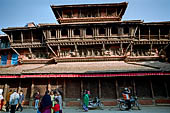
|
Full of souvenir sellers Basantapur Square is closed from the north by the Royal Palace with the nine storeys Basantapur Tower and the Patan Tower. From Basantapur square we passed in front of the Kumari Bahal to reach the south west corner of the square. Here there are a group of temples not in the best state of conservation and widely used by locals for small shops and markets, this far from being a nuisance is one of the most beautiful features of the Kathmandu lifestyle, actually Durbar square it is not a museum but rather a truly leaving place where art religion and everyday life mix together, something that in western countries has been lost forever.
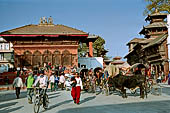
|
Kathmandu Durbar Square
|
The first temple we encountered is the three roofed Trailokya Mohan Temple (XVII C deity: Vishnu). In front is a big stone statue of the winged Garuda (XVII C). Nearby is the two storeyed Laksmi Narayan temple and the famous Kasthamandap (House of Wood) (XII C deity: Gorakhnath), an unattractive three storey temple, one of the oldest wooden building of the valley. Opposite the Kabindrapur Temple (XVII C) home to Shiva Nataraj, the roof has some finely carved wooden struts supporting a protruding verandah with intricately carved windows.
Kathmandu Durbar Square |
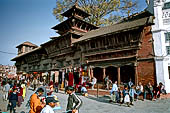
|
To the north the square widens, the platform of the big Maju Dewal (under renovation at the time of our visit) is used by street sellers to display their goods. Behind the temple popularly known as the Shiva Parvati temple, (XVIII C) with the two deities leaning from a window greeting to the people below, its architecture is similar in stryle to a traditional Newari house. Next to it, the three-storeyed Narayan Temple. On the other side of the square, built on top of the buildings enclosing the Hanuman Doka palace is the tripled roofed Bhagwati Temple (XVIII C) with some of the most beautiful wooden window and balcony of the square, below some souvenir shops. Adjacent to it, on the corner balcony, the beautiful Ivory Window another example of fine craftsmanship. In front of Bhagwati temple there are three stone temples: the first from left is dedicated to Vishnu the other to Saraswati and finally the three-tiered eight sided Krishna Temple (XVIII C).
On the right end side the Pratap Malla column, (XVII C) the king with his two wives and sons, looks into his private prayer room of the three-tiered pagoda Degutaleju Temple (XVII C). This three storied temple stands on a broad, tower like base belonging to the palace. Hidden behind a latticed door is the famous Seto Bhairab (White Bhairab) displayed only for a few days during the Indra Jatra Festival (held in September).
Walking towards the entrance of Hanuman Dhoka royal palace on your left there is the Jagannath Temple. This two-storied building on a stepped platform stands in a prominent position in front of the Hnuman Doka. In its present form it is in the Pachayatana type, the corners of the platform have secondary shrines on separate bases added in later times. The side entrances on all four portals have been walled up.
To the left of the entrance gate to Hanuman Dhoka palace there is the statue of Hanuman covered in a red cloth. Nearby outside the palace wall is a stone inscription (XVII C).

|
Kathmandu Durbar Square
|
Going back to Makhan Tole you will not miss the large stone statue of Kala Bhairab (Black Bhairab). To the side the pair of Indrapur Temple and the three tiered roof Vishnu Temple. Impossible to miss the bright white spire of Kakeshwar Temple built on top of a base in Nepali style.
From here the magnificent Taleju Temple (xvi c) is well visible from inside its enclosure wall, the entrance (closed) is the brightly painted Singha Dhoka (Door of the Lion) guarded by two stone lions. The pair of small Mahadev temples (under renovation at the time of our visit) flank the entrance to the shrine.
The temple of Taleju (the tutelary goddess to the Malla kings of Kathmandu) surpasses in eight and monumental effect all other temples of the valley. It is a three storied temple on a stepped mountain like base divided into three horizontal levels: the lower section has a broad terrace lined with twelve secondary shrines, a further base with four secondary shrines and finally the third very steep level which serve as platform for the main temple.
Kathmandu Durbar Square |
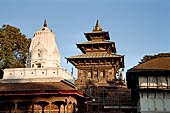
|
Opposite on the other side of the square the triple-roofed Maha Vishnu Temple (xviii c) and, at the northern end of the square, Mahendreshwar temple (xvi c deity: Siva).
Further to the East the crowded Makhan Tole, the road that eventually leads to Indra Chowk, starts in correspondence of a statue of Garuda (vi c) kneeled in front of a small Vishnu temple.
To the right, inside a courtyard, the Tana Deval temple (xvi c); its carved roof struts represent multi-armed Ashtamatrikas (the eight mother goddesses).

|
Kathmandu Durbar Square
|
Hanuman Dhoka
The former Royal Palace of the Malla kings takes its name from the brightly painted entrance gate. As soon as you enter on the left near the guard post there is a stone sculpture of Narsingha, then you enter into the Nasal Chowk, the ‘dancing one’, from the Dancing Siva image, the first of the several courtyards (chowks) of the palace, most of which are closed to the public. At the south side there is the nine storeys Basantapur Tower with the intricately carved wooden verandas, beautiful windows and superb carvings on roof struts. On the northeast corner you can see Panch Mukhi Hanuman Temple with its five circular roofs. Basantapur Tower can be visited.
Hanuman Dhoka |
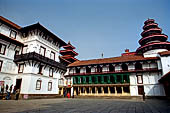
|
On the west side of Nasal Chowk the Tribhuwan Museum contains an exhibit of items of King Tribhuwan the grandfather of the present king. There are many photos and newspaper clipping.
The towers around Lohan Chowk represent the old cities of the Kathmandu Valley: in addition to the Basantapur Tower (Kathmandu), there are the Kirtipur Tower, the Bhaktapur Tower and the Lalitpur Tower (Patan).

|
Hanuman Dhoka
|
| |
|
|
 |
|



